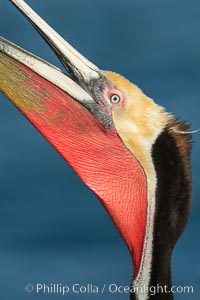
California Brown Pelican head throw, stretching its throat to keep it flexible and healthy. Note the winter breeding plumage, olive and red throat, yellow head.
Species: Brown Pelican, Pelecanus occidentalis, Pelecanus occidentalis californicus
Location: La Jolla, California
Image ID: 30413
Species: Brown Pelican, Pelecanus occidentalis, Pelecanus occidentalis californicus
Location: La Jolla, California
Image ID: 30413
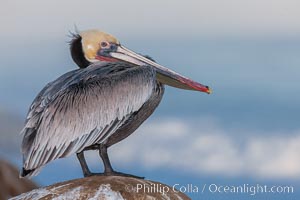
Portrait of California brown pelican, with the characteristic winter breeding plumage shown: red throat, yellow head and dark brown hindneck.
Species: Brown Pelican, Pelecanus occidentalis, Pelecanus occidentalis californicus
Location: La Jolla, California
Image ID: 23654
Species: Brown Pelican, Pelecanus occidentalis, Pelecanus occidentalis californicus
Location: La Jolla, California
Image ID: 23654
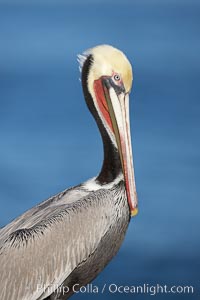
Brown pelican, winter plumage, showing bright red gular pouch and dark brown hindneck colors of breeding adults. This large seabird has a wingspan over 7 feet wide. The California race of the brown pelican holds endangered species status, due largely to predation in the early 1900s and to decades of poor reproduction caused by DDT poisoning.
Species: Brown Pelican, Pelecanus occidentalis, Pelecanus occidentalis californicus
Location: La Jolla, California
Image ID: 20075
Species: Brown Pelican, Pelecanus occidentalis, Pelecanus occidentalis californicus
Location: La Jolla, California
Image ID: 20075
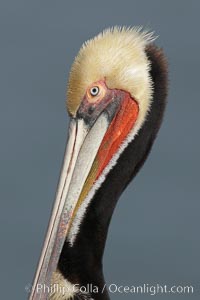
Brown pelican portrait, displaying winter breeding plumage with distinctive dark brown nape, yellow head feathers and red gular throat pouch.
Species: Brown Pelican, Pelecanus occidentalis, Pelecanus occidentalis californicus
Location: La Jolla, California
Image ID: 20231
Species: Brown Pelican, Pelecanus occidentalis, Pelecanus occidentalis californicus
Location: La Jolla, California
Image ID: 20231
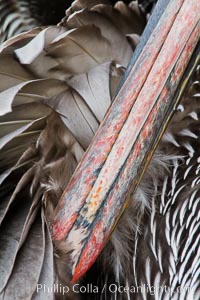
California brown pelican preening, bill and feather detail.
Species: Brown Pelican, Pelecanus occidentalis, Pelecanus occidentalis californicus
Location: La Jolla, California
Image ID: 27260
Species: Brown Pelican, Pelecanus occidentalis, Pelecanus occidentalis californicus
Location: La Jolla, California
Image ID: 27260
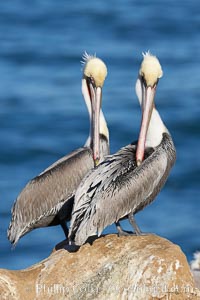
Brown pelicans preening. After wiping its long beak on the uropygial gland near the base of its tail, the pelican spreads the preen oil on feathers about its body, helping to keep them water resistant, an important protection for a bird that spends much of its life diving in the ocean for prey.
Species: Brown Pelicans, Pelecanus occidentalis, Pelecanus occidentalis californicus
Location: La Jolla, California
Image ID: 20034
Species: Brown Pelicans, Pelecanus occidentalis, Pelecanus occidentalis californicus
Location: La Jolla, California
Image ID: 20034
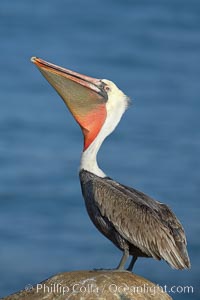
Brown pelican raising its bill in a head throw to stretch is throat. Winter plumage, non-mating coloration.
Species: Brown Pelican, Pelecanus occidentalis, Pelecanus occidentalis californicus
Location: La Jolla, California
Image ID: 20155
Species: Brown Pelican, Pelecanus occidentalis, Pelecanus occidentalis californicus
Location: La Jolla, California
Image ID: 20155
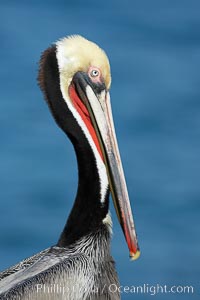
Brown pelican portrait, winter breeding plumage with distinctive dark brown nape and red gular throat pouch.
Species: Brown Pelican, Pelecanus occidentalis, Pelecanus occidentalis californicus
Location: La Jolla, California
Image ID: 20158
Species: Brown Pelican, Pelecanus occidentalis, Pelecanus occidentalis californicus
Location: La Jolla, California
Image ID: 20158
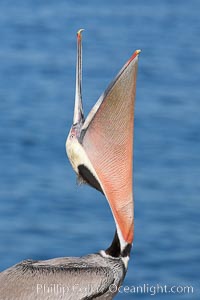
Brown pelican head throw, winter plumage, showing bright red gular pouch and dark brown hindneck plumage of breeding adults. During a bill throw, the pelican arches its neck back, lifting its large bill upward and stretching its throat pouch.
Species: Brown Pelican, Pelecanus occidentalis, Pelecanus occidentalis californicus
Location: La Jolla, California
Image ID: 20204
Species: Brown Pelican, Pelecanus occidentalis, Pelecanus occidentalis californicus
Location: La Jolla, California
Image ID: 20204
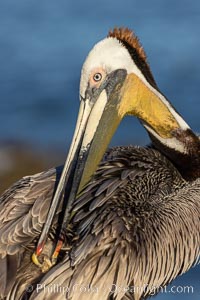
A brown pelican preening, reaching with its beak to the uropygial gland (preen gland) near the base of its tail. Preen oil from the uropygial gland is spread by the pelican's beak and back of its head to all other feathers on the pelican, helping to keep them water resistant and dry. Note the yellow throat of this individual, different than the more typical red throat.
Species: Brown Pelican, Pelecanus occidentalis, Pelecanus occidentalis californicus
Location: La Jolla, California
Image ID: 36844
Species: Brown Pelican, Pelecanus occidentalis, Pelecanus occidentalis californicus
Location: La Jolla, California
Image ID: 36844
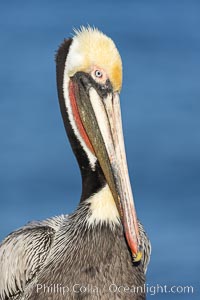
California brown pelican portrait with breeding plumage, note the striking red throat, yellow and white head.
Species: Brown Pelican, Pelecanus occidentalis, Pelecanus occidentalis californicus
Location: La Jolla, California
Image ID: 37610
Species: Brown Pelican, Pelecanus occidentalis, Pelecanus occidentalis californicus
Location: La Jolla, California
Image ID: 37610
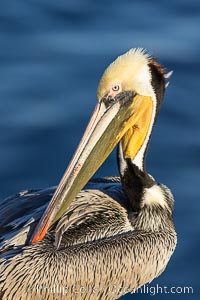
California brown pelican breeding plumage portrait. While this adult brown pelican exhibits the brown hind neck of a breeding adult, it displays an unusual yellow throat rather than the more typical red throat.
Species: Brown Pelican, Pelecanus occidentalis, Pelecanus occidentalis californicus
Location: La Jolla, California
Image ID: 38670
Species: Brown Pelican, Pelecanus occidentalis, Pelecanus occidentalis californicus
Location: La Jolla, California
Image ID: 38670
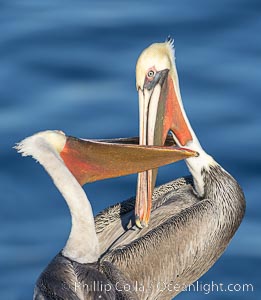
Brown pelicans jousting with their long bills, competing for space on a sea cliff over the ocean, with bright red throat, yellow and white head, adult non-breeding winter plumage.
Species: Brown Pelican, Pelecanus occidentalis, Pelecanus occidentalis californicus
Location: La Jolla, California
Image ID: 38671
Species: Brown Pelican, Pelecanus occidentalis, Pelecanus occidentalis californicus
Location: La Jolla, California
Image ID: 38671
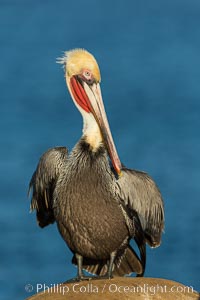
Brown pelican portrait, displaying winter plumage with distinctive yellow head feathers and red gular throat pouch.
Species: Brown Pelican, Pelecanus occidentalis, Pelecanus occidentalis californicus
Location: La Jolla, California
Image ID: 30256
Species: Brown Pelican, Pelecanus occidentalis, Pelecanus occidentalis californicus
Location: La Jolla, California
Image ID: 30256
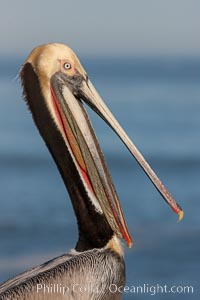
Portrait of California brown pelican, with the characteristic winter mating plumage shown: red throat, yellow head and dark brown hindneck.
Species: Brown Pelican, Pelecanus occidentalis, Pelecanus occidentalis californicus
Location: La Jolla, California
Image ID: 23649
Species: Brown Pelican, Pelecanus occidentalis, Pelecanus occidentalis californicus
Location: La Jolla, California
Image ID: 23649
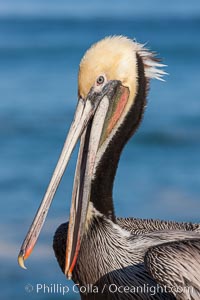
Portrait of California brown pelican, with the characteristic winter mating plumage shown: red throat, yellow head and dark brown hindneck.
Species: Brown Pelican, Pelecanus occidentalis, Pelecanus occidentalis californicus
Location: La Jolla, California
Image ID: 23653
Species: Brown Pelican, Pelecanus occidentalis, Pelecanus occidentalis californicus
Location: La Jolla, California
Image ID: 23653
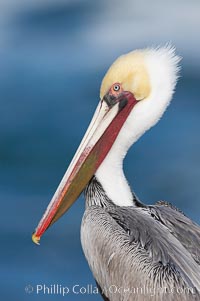
Brown pelican, adult winter non-breeding plumage showing white hindneck and red gular throat pouch.. This large seabird has a wingspan over 7 feet wide. The California race of the brown pelican holds endangered species status, due largely to predation in the early 1900s and to decades of poor reproduction caused by DDT poisoning.
Species: Brown Pelican, Pelecanus occidentalis, Pelecanus occidentalis californicus
Location: La Jolla, California
Image ID: 15130
Species: Brown Pelican, Pelecanus occidentalis, Pelecanus occidentalis californicus
Location: La Jolla, California
Image ID: 15130
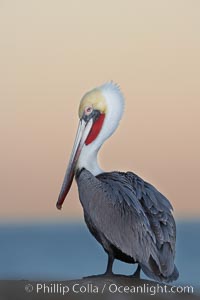
Brown pelican, non-breeding winter plumage. This large seabird has a wingspan over 7 feet wide. The California race of the brown pelican holds endangered species status, due largely to predation in the early 1900s and to decades of poor reproduction caused by DDT poisoning.
Species: Brown Pelican, Pelecanus occidentalis, Pelecanus occidentalis californicus
Location: La Jolla, California
Image ID: 20078
Species: Brown Pelican, Pelecanus occidentalis, Pelecanus occidentalis californicus
Location: La Jolla, California
Image ID: 20078
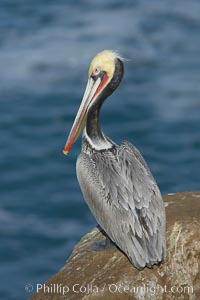
Brown pelican portrait, resting on sandstone cliffs beside the sea, winter mating plumage with distinctive dark brown nape and red gular throat pouch.
Species: Brown Pelican, Pelecanus occidentalis, Pelecanus occidentalis californicus
Location: La Jolla, California
Image ID: 20157
Species: Brown Pelican, Pelecanus occidentalis, Pelecanus occidentalis californicus
Location: La Jolla, California
Image ID: 20157
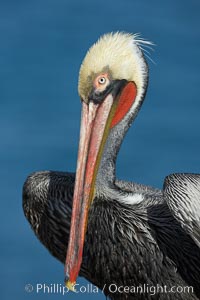
Brown pelican portrait, winter mating plumage with distinctive dark brown nape and red gular throat pouch.
Species: Brown Pelican, Pelecanus occidentalis, Pelecanus occidentalis californicus
Location: La Jolla, California
Image ID: 20168
Species: Brown Pelican, Pelecanus occidentalis, Pelecanus occidentalis californicus
Location: La Jolla, California
Image ID: 20168
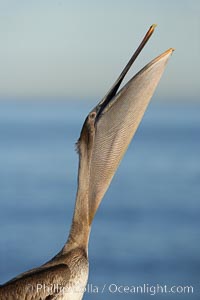
Brown pelican head throw, winter plumage, showing bright red gular pouch and dark brown hindneck plumage of breeding adults. During a bill throw, the pelican arches its neck back, lifting its large bill upward and stretching its throat pouch.
Species: Brown Pelican, Pelecanus occidentalis, Pelecanus occidentalis californicus
Location: La Jolla, California
Image ID: 20188
Species: Brown Pelican, Pelecanus occidentalis, Pelecanus occidentalis californicus
Location: La Jolla, California
Image ID: 20188
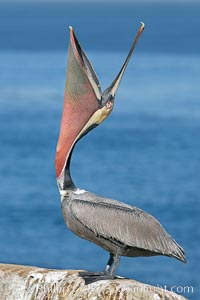
Brown pelican head throw, winter plumage, showing bright red gular pouch and dark brown hindneck plumage of breeding adults. During a bill throw, the pelican arches its neck back, lifting its large bill upward and stretching its throat pouch.
Species: Brown Pelican, Pelecanus occidentalis, Pelecanus occidentalis californicus
Location: La Jolla, California
Image ID: 20205
Species: Brown Pelican, Pelecanus occidentalis, Pelecanus occidentalis californicus
Location: La Jolla, California
Image ID: 20205
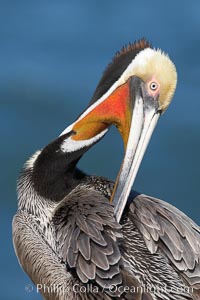
A brown pelican preening, reaching with its beak to the uropygial gland (preen gland) near the base of its tail. Preen oil from the uropygial gland is spread by the pelican's beak and back of its head to all other feathers on the pelican, helping to keep them water resistant and dry. Note adult winter breeding plumage in display, with brown neck, red gular throat pouch and yellow and white head.
Species: Brown Pelican, Pelecanus occidentalis, Pelecanus occidentalis californicus
Location: La Jolla, California
Image ID: 20295
Species: Brown Pelican, Pelecanus occidentalis, Pelecanus occidentalis californicus
Location: La Jolla, California
Image ID: 20295
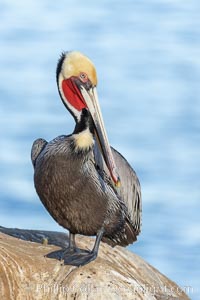
California Brown pelican portrait, displaying breeding plumage with distinctive yellow and white head feathers, red gular throat pouch, brown hind neck and greyish body.
Species: Brown Pelican, Pelecanus occidentalis, Pelecanus occidentalis californicus
Location: La Jolla, California
Image ID: 37633
Species: Brown Pelican, Pelecanus occidentalis, Pelecanus occidentalis californicus
Location: La Jolla, California
Image ID: 37633
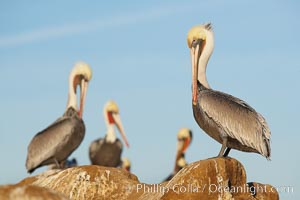
Brown pelican drying its feathers in the morning sun. Adult winter non-breeding plumage showing white hindneck and red gular throat pouch.
Species: Brown Pelican, Pelecanus occidentalis, Pelecanus occidentalis californicus
Location: La Jolla, California
Image ID: 20056
Species: Brown Pelican, Pelecanus occidentalis, Pelecanus occidentalis californicus
Location: La Jolla, California
Image ID: 20056
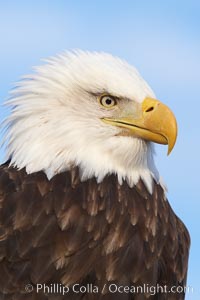
Bald eagle, closeup of head and shoulders showing distinctive white head feathers, yellow beak and brown body and wings.
Species: Bald eagle, Haliaeetus leucocephalus, Haliaeetus leucocephalus washingtoniensis
Location: Kachemak Bay, Homer, Alaska
Image ID: 22625
Species: Bald eagle, Haliaeetus leucocephalus, Haliaeetus leucocephalus washingtoniensis
Location: Kachemak Bay, Homer, Alaska
Image ID: 22625
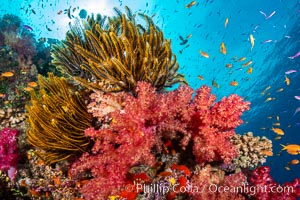
Crinoid (feather star) extends its tentacles into ocean currents, on pristine south pacific coral reef, Fiji.
Species: Crinoid feather star, Dendronephthya soft coral, Crinoidea, Dendronephthya
Location: Namena Marine Reserve, Namena Island, Fiji
Image ID: 34840
Species: Crinoid feather star, Dendronephthya soft coral, Crinoidea, Dendronephthya
Location: Namena Marine Reserve, Namena Island, Fiji
Image ID: 34840
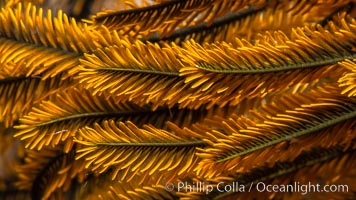
Crinoid feather star closeup view of tentacles, which it extends into ocean currents, Fiji.
Species: Crinoid feather star, Crinoidea
Location: Namena Marine Reserve, Namena Island, Fiji
Image ID: 34843
Species: Crinoid feather star, Crinoidea
Location: Namena Marine Reserve, Namena Island, Fiji
Image ID: 34843
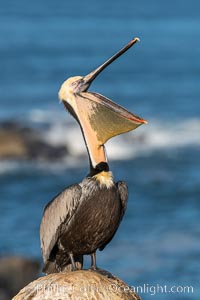
California Brown Pelican head throw, stretching its throat to keep it flexible and healthy.
Species: Brown Pelican, Pelecanus occidentalis, Pelecanus occidentalis californicus
Location: La Jolla, California
Image ID: 36692
Species: Brown Pelican, Pelecanus occidentalis, Pelecanus occidentalis californicus
Location: La Jolla, California
Image ID: 36692
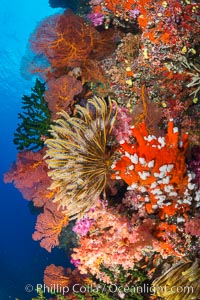
Yellow Crinoid with Sea Fan Gorgonians and Dendronephthya Soft Corals on Reef, Fiji.
Species: Crinoid feather star, Dendronephthya soft coral, Gorgonian, Crinoidea, Dendronephthya, Gorgonacea
Location: Vatu I Ra Passage, Bligh Waters, Viti Levu Island, Fiji
Image ID: 31461
Species: Crinoid feather star, Dendronephthya soft coral, Gorgonian, Crinoidea, Dendronephthya, Gorgonacea
Location: Vatu I Ra Passage, Bligh Waters, Viti Levu Island, Fiji
Image ID: 31461